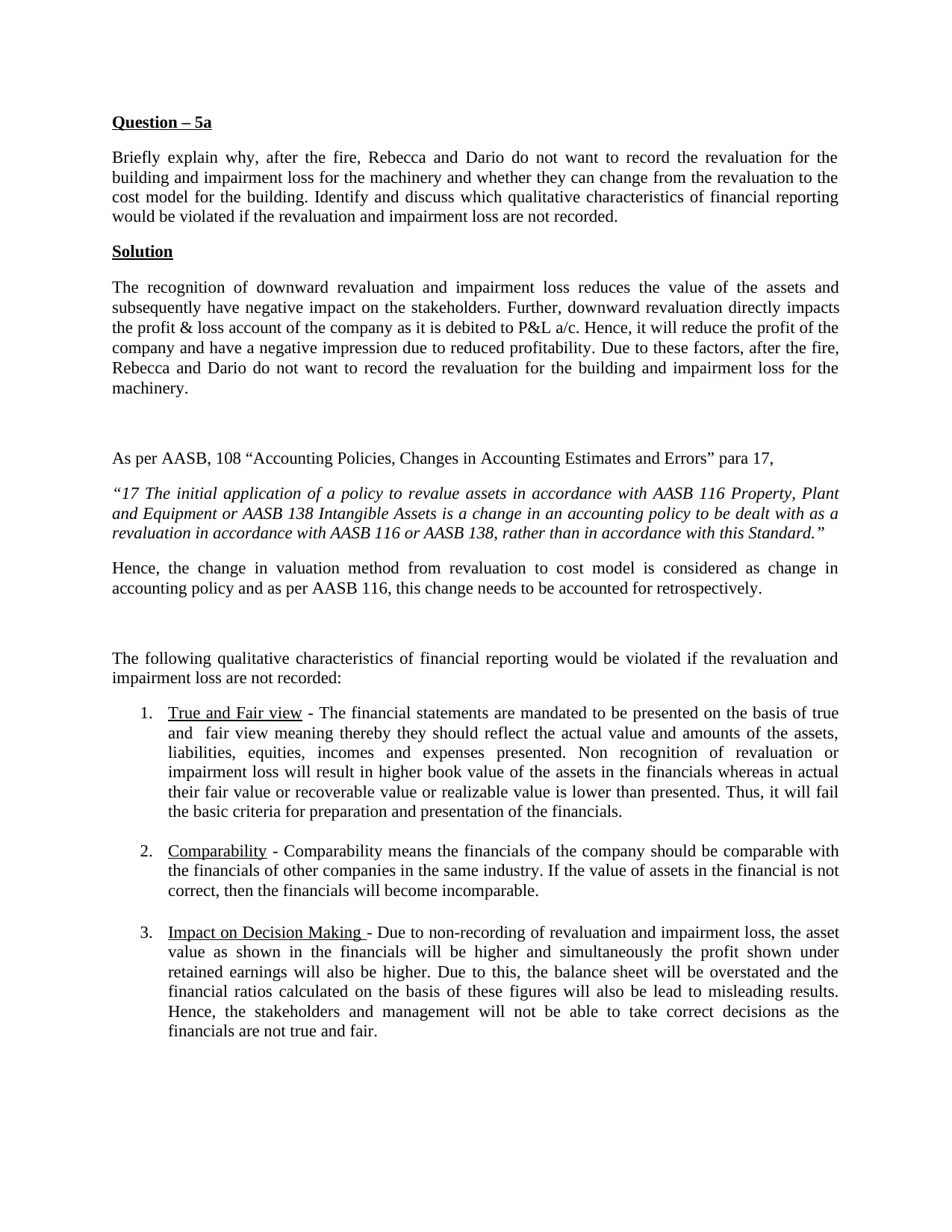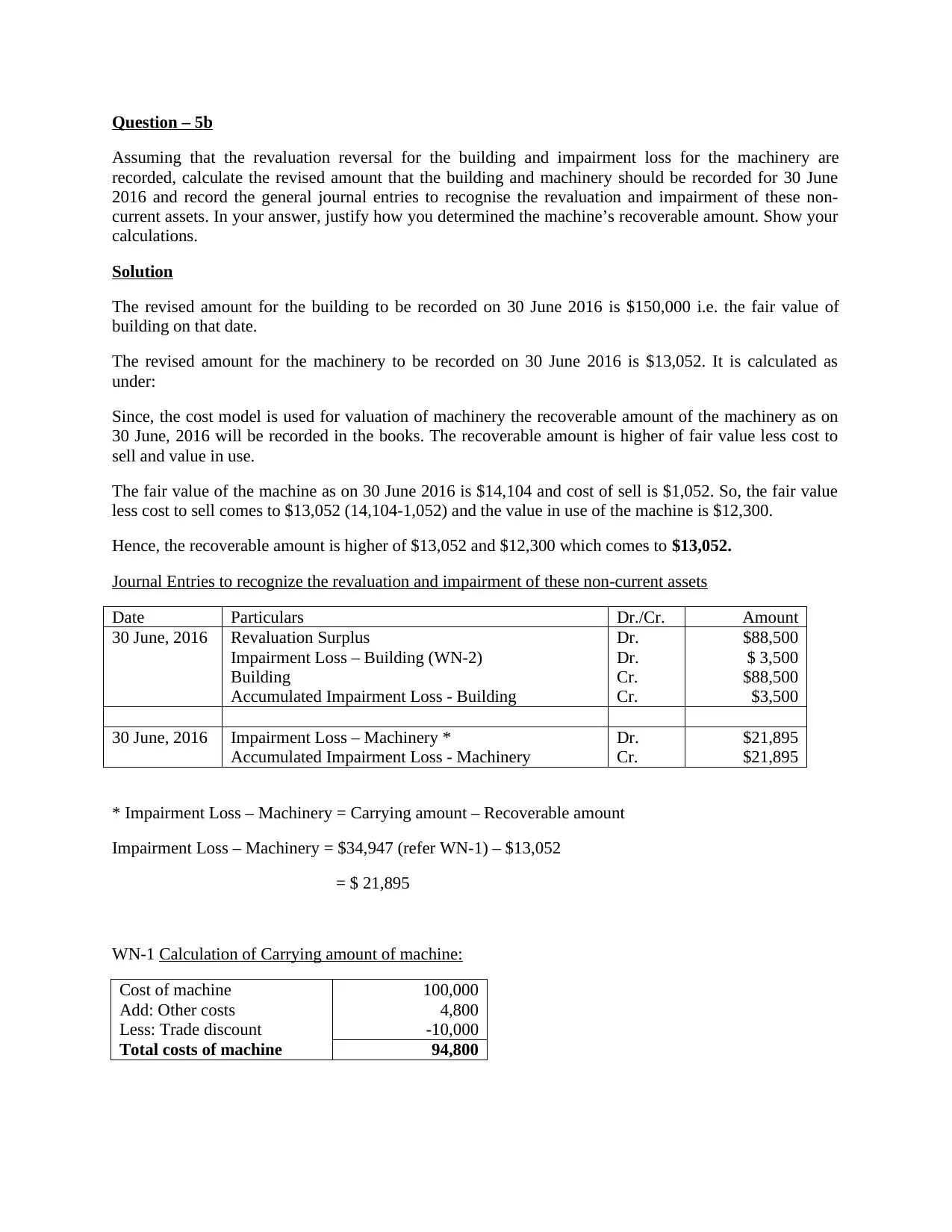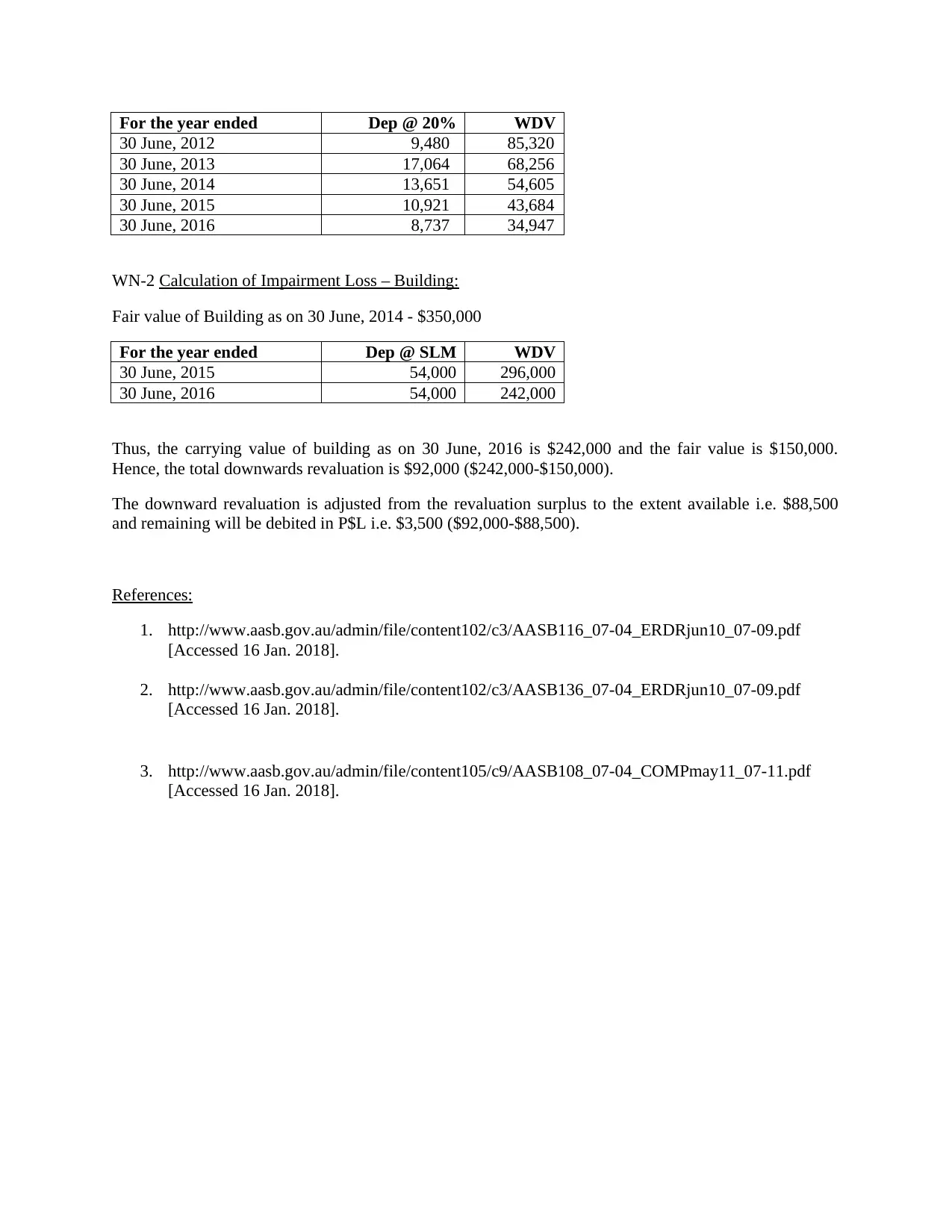Impact of Revaluation and Impairment on Financial Statements - Finance
VerifiedAdded on 2020/05/28
|3
|1077
|113
Homework Assignment
AI Summary
This finance assignment solution addresses the accounting treatment of revaluation and impairment losses on assets. It explains why companies might avoid recording these losses, emphasizing the impact on stakeholders and the profit & loss account. The solution references AASB standards and discusses the violation of qualitative characteristics if revaluation and impairment are not recorded. Furthermore, it includes detailed calculations of revised asset amounts and journal entries for the building and machinery, determining the recoverable amount of the machinery. The solution covers the calculation of carrying values and impairment losses, providing a comprehensive understanding of the concepts and their practical application in financial reporting.

Question – 5a
Briefly explain why, after the fire, Rebecca and Dario do not want to record the revaluation for the
building and impairment loss for the machinery and whether they can change from the revaluation to the
cost model for the building. Identify and discuss which qualitative characteristics of financial reporting
would be violated if the revaluation and impairment loss are not recorded.
Solution
The recognition of downward revaluation and impairment loss reduces the value of the assets and
subsequently have negative impact on the stakeholders. Further, downward revaluation directly impacts
the profit & loss account of the company as it is debited to P&L a/c. Hence, it will reduce the profit of the
company and have a negative impression due to reduced profitability. Due to these factors, after the fire,
Rebecca and Dario do not want to record the revaluation for the building and impairment loss for the
machinery.
As per AASB, 108 “Accounting Policies, Changes in Accounting Estimates and Errors” para 17,
“17 The initial application of a policy to revalue assets in accordance with AASB 116 Property, Plant
and Equipment or AASB 138 Intangible Assets is a change in an accounting policy to be dealt with as a
revaluation in accordance with AASB 116 or AASB 138, rather than in accordance with this Standard.”
Hence, the change in valuation method from revaluation to cost model is considered as change in
accounting policy and as per AASB 116, this change needs to be accounted for retrospectively.
The following qualitative characteristics of financial reporting would be violated if the revaluation and
impairment loss are not recorded:
1. True and Fair view - The financial statements are mandated to be presented on the basis of true
and fair view meaning thereby they should reflect the actual value and amounts of the assets,
liabilities, equities, incomes and expenses presented. Non recognition of revaluation or
impairment loss will result in higher book value of the assets in the financials whereas in actual
their fair value or recoverable value or realizable value is lower than presented. Thus, it will fail
the basic criteria for preparation and presentation of the financials.
2. Comparability - Comparability means the financials of the company should be comparable with
the financials of other companies in the same industry. If the value of assets in the financial is not
correct, then the financials will become incomparable.
3. Impact on Decision Making - Due to non-recording of revaluation and impairment loss, the asset
value as shown in the financials will be higher and simultaneously the profit shown under
retained earnings will also be higher. Due to this, the balance sheet will be overstated and the
financial ratios calculated on the basis of these figures will also be lead to misleading results.
Hence, the stakeholders and management will not be able to take correct decisions as the
financials are not true and fair.
Briefly explain why, after the fire, Rebecca and Dario do not want to record the revaluation for the
building and impairment loss for the machinery and whether they can change from the revaluation to the
cost model for the building. Identify and discuss which qualitative characteristics of financial reporting
would be violated if the revaluation and impairment loss are not recorded.
Solution
The recognition of downward revaluation and impairment loss reduces the value of the assets and
subsequently have negative impact on the stakeholders. Further, downward revaluation directly impacts
the profit & loss account of the company as it is debited to P&L a/c. Hence, it will reduce the profit of the
company and have a negative impression due to reduced profitability. Due to these factors, after the fire,
Rebecca and Dario do not want to record the revaluation for the building and impairment loss for the
machinery.
As per AASB, 108 “Accounting Policies, Changes in Accounting Estimates and Errors” para 17,
“17 The initial application of a policy to revalue assets in accordance with AASB 116 Property, Plant
and Equipment or AASB 138 Intangible Assets is a change in an accounting policy to be dealt with as a
revaluation in accordance with AASB 116 or AASB 138, rather than in accordance with this Standard.”
Hence, the change in valuation method from revaluation to cost model is considered as change in
accounting policy and as per AASB 116, this change needs to be accounted for retrospectively.
The following qualitative characteristics of financial reporting would be violated if the revaluation and
impairment loss are not recorded:
1. True and Fair view - The financial statements are mandated to be presented on the basis of true
and fair view meaning thereby they should reflect the actual value and amounts of the assets,
liabilities, equities, incomes and expenses presented. Non recognition of revaluation or
impairment loss will result in higher book value of the assets in the financials whereas in actual
their fair value or recoverable value or realizable value is lower than presented. Thus, it will fail
the basic criteria for preparation and presentation of the financials.
2. Comparability - Comparability means the financials of the company should be comparable with
the financials of other companies in the same industry. If the value of assets in the financial is not
correct, then the financials will become incomparable.
3. Impact on Decision Making - Due to non-recording of revaluation and impairment loss, the asset
value as shown in the financials will be higher and simultaneously the profit shown under
retained earnings will also be higher. Due to this, the balance sheet will be overstated and the
financial ratios calculated on the basis of these figures will also be lead to misleading results.
Hence, the stakeholders and management will not be able to take correct decisions as the
financials are not true and fair.
Paraphrase This Document
Need a fresh take? Get an instant paraphrase of this document with our AI Paraphraser

Question – 5b
Assuming that the revaluation reversal for the building and impairment loss for the machinery are
recorded, calculate the revised amount that the building and machinery should be recorded for 30 June
2016 and record the general journal entries to recognise the revaluation and impairment of these non-
current assets. In your answer, justify how you determined the machine’s recoverable amount. Show your
calculations.
Solution
The revised amount for the building to be recorded on 30 June 2016 is $150,000 i.e. the fair value of
building on that date.
The revised amount for the machinery to be recorded on 30 June 2016 is $13,052. It is calculated as
under:
Since, the cost model is used for valuation of machinery the recoverable amount of the machinery as on
30 June, 2016 will be recorded in the books. The recoverable amount is higher of fair value less cost to
sell and value in use.
The fair value of the machine as on 30 June 2016 is $14,104 and cost of sell is $1,052. So, the fair value
less cost to sell comes to $13,052 (14,104-1,052) and the value in use of the machine is $12,300.
Hence, the recoverable amount is higher of $13,052 and $12,300 which comes to $13,052.
Journal Entries to recognize the revaluation and impairment of these non-current assets
Date Particulars Dr./Cr. Amount
30 June, 2016 Revaluation Surplus
Impairment Loss – Building (WN-2)
Building
Accumulated Impairment Loss - Building
Dr.
Dr.
Cr.
Cr.
$88,500
$ 3,500
$88,500
$3,500
30 June, 2016 Impairment Loss – Machinery *
Accumulated Impairment Loss - Machinery
Dr.
Cr.
$21,895
$21,895
* Impairment Loss – Machinery = Carrying amount – Recoverable amount
Impairment Loss – Machinery = $34,947 (refer WN-1) – $13,052
= $ 21,895
WN-1 Calculation of Carrying amount of machine:
Cost of machine 100,000
Add: Other costs 4,800
Less: Trade discount -10,000
Total costs of machine 94,800
Assuming that the revaluation reversal for the building and impairment loss for the machinery are
recorded, calculate the revised amount that the building and machinery should be recorded for 30 June
2016 and record the general journal entries to recognise the revaluation and impairment of these non-
current assets. In your answer, justify how you determined the machine’s recoverable amount. Show your
calculations.
Solution
The revised amount for the building to be recorded on 30 June 2016 is $150,000 i.e. the fair value of
building on that date.
The revised amount for the machinery to be recorded on 30 June 2016 is $13,052. It is calculated as
under:
Since, the cost model is used for valuation of machinery the recoverable amount of the machinery as on
30 June, 2016 will be recorded in the books. The recoverable amount is higher of fair value less cost to
sell and value in use.
The fair value of the machine as on 30 June 2016 is $14,104 and cost of sell is $1,052. So, the fair value
less cost to sell comes to $13,052 (14,104-1,052) and the value in use of the machine is $12,300.
Hence, the recoverable amount is higher of $13,052 and $12,300 which comes to $13,052.
Journal Entries to recognize the revaluation and impairment of these non-current assets
Date Particulars Dr./Cr. Amount
30 June, 2016 Revaluation Surplus
Impairment Loss – Building (WN-2)
Building
Accumulated Impairment Loss - Building
Dr.
Dr.
Cr.
Cr.
$88,500
$ 3,500
$88,500
$3,500
30 June, 2016 Impairment Loss – Machinery *
Accumulated Impairment Loss - Machinery
Dr.
Cr.
$21,895
$21,895
* Impairment Loss – Machinery = Carrying amount – Recoverable amount
Impairment Loss – Machinery = $34,947 (refer WN-1) – $13,052
= $ 21,895
WN-1 Calculation of Carrying amount of machine:
Cost of machine 100,000
Add: Other costs 4,800
Less: Trade discount -10,000
Total costs of machine 94,800

For the year ended Dep @ 20% WDV
30 June, 2012 9,480 85,320
30 June, 2013 17,064 68,256
30 June, 2014 13,651 54,605
30 June, 2015 10,921 43,684
30 June, 2016 8,737 34,947
WN-2 Calculation of Impairment Loss – Building:
Fair value of Building as on 30 June, 2014 - $350,000
For the year ended Dep @ SLM WDV
30 June, 2015 54,000 296,000
30 June, 2016 54,000 242,000
Thus, the carrying value of building as on 30 June, 2016 is $242,000 and the fair value is $150,000.
Hence, the total downwards revaluation is $92,000 ($242,000-$150,000).
The downward revaluation is adjusted from the revaluation surplus to the extent available i.e. $88,500
and remaining will be debited in P$L i.e. $3,500 ($92,000-$88,500).
References:
1. http://www.aasb.gov.au/admin/file/content102/c3/AASB116_07-04_ERDRjun10_07-09.pdf
[Accessed 16 Jan. 2018].
2. http://www.aasb.gov.au/admin/file/content102/c3/AASB136_07-04_ERDRjun10_07-09.pdf
[Accessed 16 Jan. 2018].
3. http://www.aasb.gov.au/admin/file/content105/c9/AASB108_07-04_COMPmay11_07-11.pdf
[Accessed 16 Jan. 2018].
30 June, 2012 9,480 85,320
30 June, 2013 17,064 68,256
30 June, 2014 13,651 54,605
30 June, 2015 10,921 43,684
30 June, 2016 8,737 34,947
WN-2 Calculation of Impairment Loss – Building:
Fair value of Building as on 30 June, 2014 - $350,000
For the year ended Dep @ SLM WDV
30 June, 2015 54,000 296,000
30 June, 2016 54,000 242,000
Thus, the carrying value of building as on 30 June, 2016 is $242,000 and the fair value is $150,000.
Hence, the total downwards revaluation is $92,000 ($242,000-$150,000).
The downward revaluation is adjusted from the revaluation surplus to the extent available i.e. $88,500
and remaining will be debited in P$L i.e. $3,500 ($92,000-$88,500).
References:
1. http://www.aasb.gov.au/admin/file/content102/c3/AASB116_07-04_ERDRjun10_07-09.pdf
[Accessed 16 Jan. 2018].
2. http://www.aasb.gov.au/admin/file/content102/c3/AASB136_07-04_ERDRjun10_07-09.pdf
[Accessed 16 Jan. 2018].
3. http://www.aasb.gov.au/admin/file/content105/c9/AASB108_07-04_COMPmay11_07-11.pdf
[Accessed 16 Jan. 2018].
⊘ This is a preview!⊘
Do you want full access?
Subscribe today to unlock all pages.

Trusted by 1+ million students worldwide
1 out of 3
Related Documents
Your All-in-One AI-Powered Toolkit for Academic Success.
+13062052269
info@desklib.com
Available 24*7 on WhatsApp / Email
![[object Object]](/_next/static/media/star-bottom.7253800d.svg)
Unlock your academic potential
Copyright © 2020–2025 A2Z Services. All Rights Reserved. Developed and managed by ZUCOL.




